01. What is the Customer Value Journey?
Before we get started, let's assume that you wouldn't be reading this if you weren't already interested in leveraging digital marketing...
But... WHY are you interested in digital marketing? Is it because you want an online sales system that...
- Attracts the right prospective customers?
- Converts leads to sales?
- Fosters referrals and customer loyalty?
If you’re nodding YES, to any or all of these, then you’re in the right place.
Download the CVJ Optimization Guide
B2B businesses are losing significant amounts of money due to bad data and poorly configured martech. In fact, a Gartner study revealed that 30% of a company’s revenue is lost due to bad data. An exponential amount of data is created every day. But most have no idea how to use it or can’t because of siloed systems.
This underuse of martech tools (you're paying big money for!) is holding you back.
Tools fail to provide the relevant customer insights they promised. Business intelligence arrives after the opportunity has passed. It's impossible to target the right prospects or optimize campaigns. Not only are you not getting the ROI you expected from these technologies, you can't prove the ROI you know your team is producing.
Poorly configured martech often fails to provide relevant customer insights in a timely manner, making it difficult to target the right prospects and optimize campaigns, resulting in a decrease in ROI.
Why is digital marketing so important for your success?
More and more sales are taking place online. In 2020, eCommerce sales are expected to account for 15.5 percent of retail sales worldwide. By 2021, worldwide online sales are expected to reach $4.5 trillion. Think it's different for B2B? Think again - research conducted by Frost and Sullivan predicts B2B ecommerce sales to reach $12 trillion globally in 2020, with China and the US leading the global market.
In fact, it’s estimated that 95 percent of purchases will be made online by 2040.
This means if you don’t have a plan for maximizing your digital presence, you're going to miss out on the industry’s greatest revenue growth opportunity.
The time to act is now.
Just check out the latest data on digital marketing for the travel industry from CMO.com, Expedia and American Express:
CMO.com
96%
Expedia
57%
American Express
85%
B2B businesses are losing significant amounts of money due to bad data and poorly configured martech. In fact, a Gartner study revealed that 30% of a company’s revenue is lost due to bad data. An exponential amount of data is created every day. But most have no idea how to use it or can’t because of siloed systems.
This underuse of martech tools (you're paying big money for!) is holding you back.
Tools fail to provide the relevant customer insights they promised. Business intelligence arrives after the opportunity has passed. It's impossible to target the right prospects or optimize campaigns. Not only are you not getting the ROI you expected from these technologies, you can't prove the ROI you know your team is producing.
Poorly configured martech often fails to provide relevant customer insights in a timely manner, making it difficult to target the right prospects and optimize campaigns, resulting in a decrease in ROI.
So What Exactly Is Customer Value Journey Optimization?
Over the years we’ve learned (and continue to learn) a lot about what works and what doesn’t, and we’ve found that the path to digital marketing success begins with a well-defined Roadmap – this is the Customer Value Journey.
The CVJ is a powerful take on the traditional “sales funnel” – it’s the path that your prospects take from “Stranger” to “Customer” to “Promoter” broken out into defined steps.
Successful digital marketing is all about optimizing the CVJ to maximize customer experience and lifetime value.
Customer Value Journey optimization is a system first defined by Digital Marketer© and now customized by our team specifically for online businesses to maximize the potential value of prospects and customers in your sales funnel.
Without a roadmap and strategy, tactics are a waste of money.
The CVJ provides the context for the tactics and a system for success. In this article, we’re going to show you, step-by-step how to optimize the Roadmap into an effective sales system.
B2B businesses are losing significant amounts of money due to bad data and poorly configured martech. In fact, a Gartner study revealed that 30% of a company’s revenue is lost due to bad data. An exponential amount of data is created every day. But most have no idea how to use it or can’t because of siloed systems.
This underuse of martech tools (you're paying big money for!) is holding you back.
Tools fail to provide the relevant customer insights they promised. Business intelligence arrives after the opportunity has passed. It's impossible to target the right prospects or optimize campaigns. Not only are you not getting the ROI you expected from these technologies, you can't prove the ROI you know your team is producing.
Poorly configured martech often fails to provide relevant customer insights in a timely manner, making it difficult to target the right prospects and optimize campaigns, resulting in a decrease in ROI.
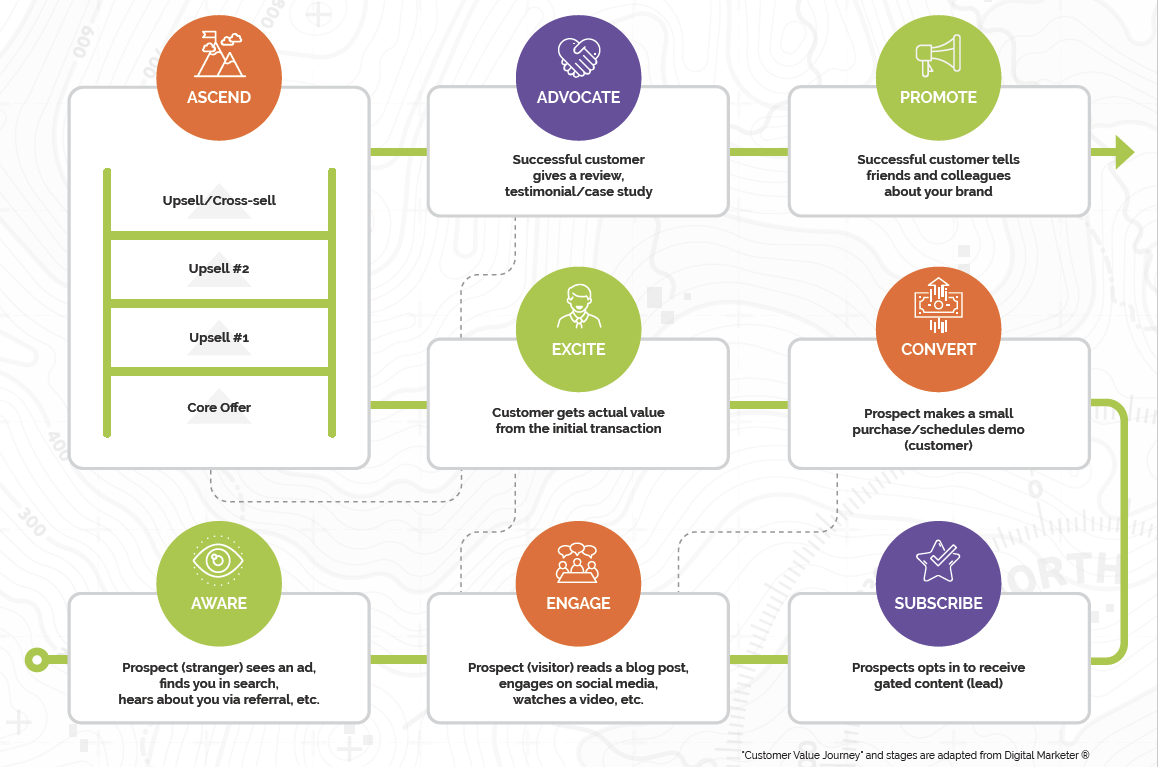
02. Generate sales on "autopilot"
What would it be like if you could confidently generate sales revenue on autopilot?with emails and ads. We all get a constant strea, of requests to purchase, download, buy or sign-up for something new.
B2B businesses are losing significant amounts of money due to bad data and poorly configured martech. In fact, a Gartner study revealed that 30% of a company’s revenue is lost due to bad data. An exponential amount of data is created every day. But most have no idea how to use it or can’t because of siloed systems.
This underuse of martech tools (you're paying big money for!) is holding you back.
Tools fail to provide the relevant customer insights they promised. Business intelligence arrives after the opportunity has passed. It's impossible to target the right prospects or optimize campaigns. Not only are you not getting the ROI you expected from these technologies, you can't prove the ROI you know your team is producing.
Poorly configured martech often fails to provide relevant customer insights in a timely manner, making it difficult to target the right prospects and optimize campaigns, resulting in a decrease in ROI.
What would it be like if you could confidently generate sales revenue on autopilot?
When done right, digital marketing can be used to make that possibility a reality.
Integrating the elements of digital marketing – your website, your email communications, your social media presence – into a powerful conversion funnel enables you to automate your sales and marketing processes, resulting in predictable online sales - giving you the opportunity to concentrate on delivering unbeatable customer service to increase repeat sales and referrals.
- This “automated sales machine” works in conjunction with your conventional marketing and sales efforts such as broadcast and wholesalers.
- You'll find your automated marketing to be much more profitable than using offline tactics. For every $1 spent, email marketing generates $32 in ROI.
- Automated emails and chatbots can engage and convert leads 24/7, which is important because that's the number one reason people shop online.
When you can get customers more quickly and easily through a well-engineered conversion funnel, you improve your margins. This means you can afford to spend more than your competitors on acquiring new customers.
In this article, we will share exactly how we build fully automated booking machines using the CVJ process.
After reading this article, you should be equipped to model a digital marketing plan for your business that will transform your marketing into a predictable engine for growth for your online store, SaaS company, airline or resort.
B2B businesses are losing significant amounts of money due to bad data and poorly configured martech. In fact, a Gartner study revealed that 30% of a company’s revenue is lost due to bad data. An exponential amount of data is created every day. But most have no idea how to use it or can’t because of siloed systems.
This underuse of martech tools (you're paying big money for!) is holding you back.
Tools fail to provide the relevant customer insights they promised. Business intelligence arrives after the opportunity has passed. It's impossible to target the right prospects or optimize campaigns. Not only are you not getting the ROI you expected from these technologies, you can't prove the ROI you know your team is producing.
Poorly configured martech often fails to provide relevant customer insights in a timely manner, making it difficult to target the right prospects and optimize campaigns, resulting in a decrease in ROI.
Use your first CVJ optimization tool right now…
Diaz & Cooper exists to deliver a “done for you” marketing solution. We offer tools and guidance for every stage of your digital marketing funnel, and we’re so serious about building a genuine partnership with you that we’re happy to share a free copy of our Customer Value Journey map in fillable PDF format. You can use it to fill in your tactics as you follow along with the article. Just click below:
03. Optimizing the Customer Value Journey.
How does Customer Value Journey optimization work?
B2B businesses are losing significant amounts of money due to bad data and poorly configured martech. In fact, a Gartner study revealed that 30% of a company’s revenue is lost due to bad data. An exponential amount of data is created every day. But most have no idea how to use it or can’t because of siloed systems.
This underuse of martech tools (you're paying big money for!) is holding you back.
Tools fail to provide the relevant customer insights they promised. Business intelligence arrives after the opportunity has passed. It's impossible to target the right prospects or optimize campaigns. Not only are you not getting the ROI you expected from these technologies, you can't prove the ROI you know your team is producing.
Poorly configured martech often fails to provide relevant customer insights in a timely manner, making it difficult to target the right prospects and optimize campaigns, resulting in a decrease in ROI.
The first thing you need to know is this: Your Customer Value Journey (sales funnel) is NOT about you.
It’s really not even about your store, products, or services.
An optimized CVJ converts because it is focused entirely on your customers.
There are only 3 ways to grow your business, and a good sales funnel must deliver on at least one of them:
• Attract more customers (more sales)
• Grow the average value of each sales transaction per customer (bigger sales)
• Increase the average number of sales transactions per customer (more frequency/loyalty)
With the Customer Value Journey, you are creating a system that can deliver on all the ways to grow your business. Here is a visual of how the CVJ optimization process works:
B2B businesses are losing significant amounts of money due to bad data and poorly configured martech. In fact, a Gartner study revealed that 30% of a company’s revenue is lost due to bad data. An exponential amount of data is created every day. But most have no idea how to use it or can’t because of siloed systems.
This underuse of martech tools (you're paying big money for!) is holding you back.
Tools fail to provide the relevant customer insights they promised. Business intelligence arrives after the opportunity has passed. It's impossible to target the right prospects or optimize campaigns. Not only are you not getting the ROI you expected from these technologies, you can't prove the ROI you know your team is producing.
Poorly configured martech often fails to provide relevant customer insights in a timely manner, making it difficult to target the right prospects and optimize campaigns, resulting in a decrease in ROI.
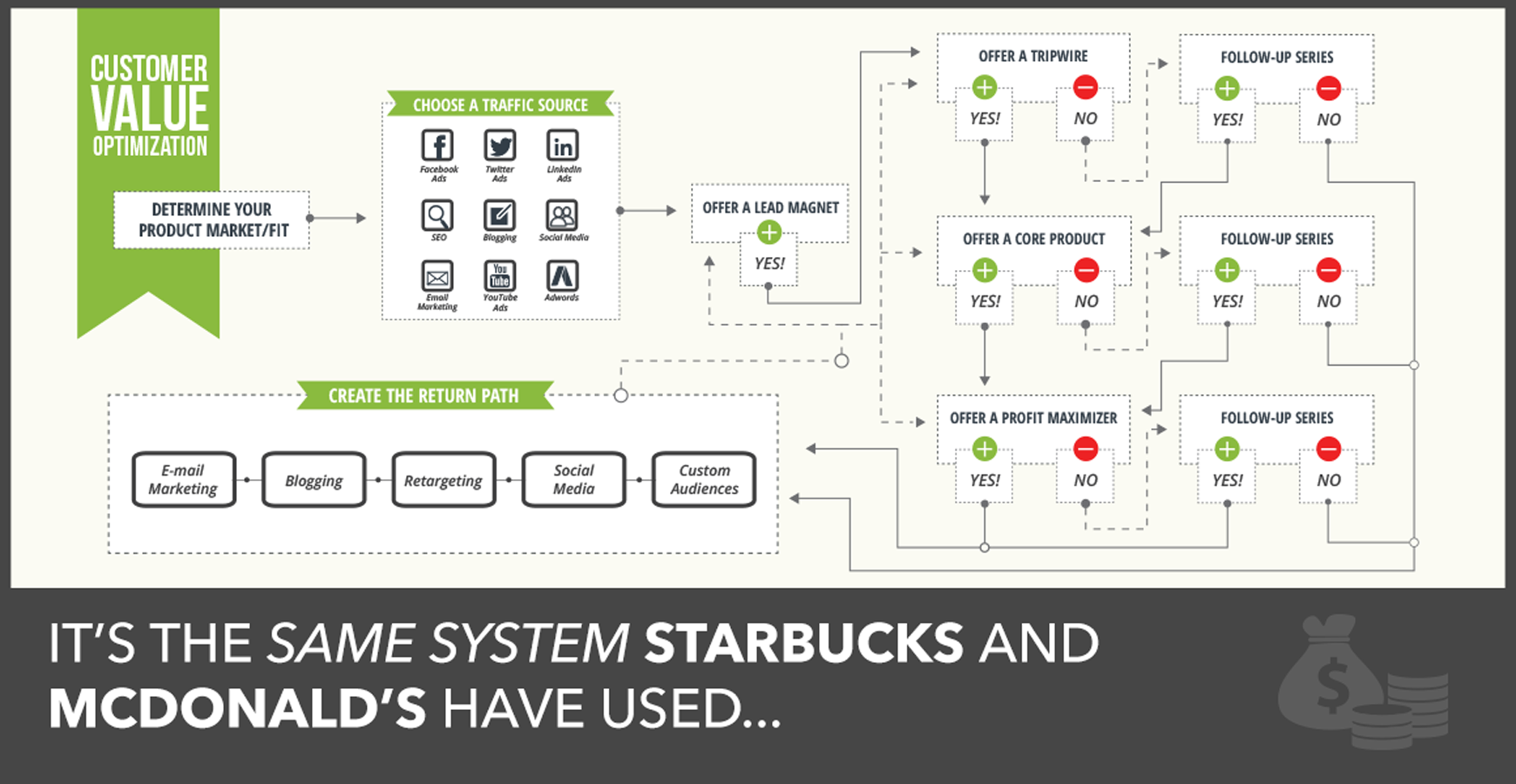
B2B businesses are losing significant amounts of money due to bad data and poorly configured martech. In fact, a Gartner study revealed that 30% of a company’s revenue is lost due to bad data. An exponential amount of data is created every day. But most have no idea how to use it or can’t because of siloed systems.
This underuse of martech tools (you're paying big money for!) is holding you back.
Tools fail to provide the relevant customer insights they promised. Business intelligence arrives after the opportunity has passed. It's impossible to target the right prospects or optimize campaigns. Not only are you not getting the ROI you expected from these technologies, you can't prove the ROI you know your team is producing.
Poorly configured martech often fails to provide relevant customer insights in a timely manner, making it difficult to target the right prospects and optimize campaigns, resulting in a decrease in ROI.
We’ll do a deep dive on the steps outlined in this image later, but for now, here's a high-level overview of what you do at each step to attract more customers, get them to spend more, and increase buying frequency.
The steps to Customer Value Journey optimization:
Here's what you'll need in order to grow your business online:
Get More Leads and Sales
- Step 1. Determine Your Product/Market Fit
- Step 2. Choose Your Traffic Source(s)
- Step 3. Offer A Lead Magnet
- Step 4. Offer a Tripwire
- Step 5. Offer Your Core Product
Get Them To Spend More
- Step 6. Offer A Profit Maximizer
Increase Buying Frequency
- Step 7. Create A Return Path
Complete these 7 steps and you’ll have the foundation for true digital scalability! Now, let's dive into each of the steps...
04. Step 1 – Determine Your Product/Market Fit
Most marketing fails because it's not targeted well, the offer is not compelling or the message does not show how you solve their wants or needs
B2B businesses are losing significant amounts of money due to bad data and poorly configured martech. In fact, a Gartner study revealed that 30% of a company’s revenue is lost due to bad data. An exponential amount of data is created every day. But most have no idea how to use it or can’t because of siloed systems.
This underuse of martech tools (you're paying big money for!) is holding you back.
Tools fail to provide the relevant customer insights they promised. Business intelligence arrives after the opportunity has passed. It's impossible to target the right prospects or optimize campaigns. Not only are you not getting the ROI you expected from these technologies, you can't prove the ROI you know your team is producing.
Poorly configured martech often fails to provide relevant customer insights in a timely manner, making it difficult to target the right prospects and optimize campaigns, resulting in a decrease in ROI.
In other words, bad marketing...
- ...doesn't define a specific customer to attract;
- ...doesn't communicate the prospect's desired “After” state;
- ...fails to show visitors how you take them from the“Before” to the “After” state
Needless to say, getting clear on your ideal customer and the desired outcome your offer delivers is fundamental to the success of your business.
Here’s how to get that clarity:
Define your Buyer Persona
If you are talking to “everybody” then you are talking to “nobody.” The biggest reason marketing campaigns underperform is because they target too broad of an audience, with a generic “one size fits all” message. Conversely, marketers who use segmented campaigns noted as much as a 760% increase in revenue.
Buyer personas are important for guiding all aspects of your marketing plan, from website and blog content to social media and email strategies.
A buyer persona is a semi-fictional representation of your ideal customer based on market research and real data about your existing customers. By defining your buyer persona at the beginning of every marketing campaign you can avoid falling into the generic marketing trap.
A quick and effective way to create your buyer persona(s) is to think about the customers you currently have that are most profitable for your business, then note their general demographics, behavior patterns, motivations, and goals. The more detailed you are, the better.
As an example, here is what a buyer persona might look like for a resort property.
B2B businesses are losing significant amounts of money due to bad data and poorly configured martech. In fact, a Gartner study revealed that 30% of a company’s revenue is lost due to bad data. An exponential amount of data is created every day. But most have no idea how to use it or can’t because of siloed systems.
This underuse of martech tools (you're paying big money for!) is holding you back.
Tools fail to provide the relevant customer insights they promised. Business intelligence arrives after the opportunity has passed. It's impossible to target the right prospects or optimize campaigns. Not only are you not getting the ROI you expected from these technologies, you can't prove the ROI you know your team is producing.
Poorly configured martech often fails to provide relevant customer insights in a timely manner, making it difficult to target the right prospects and optimize campaigns, resulting in a decrease in ROI.
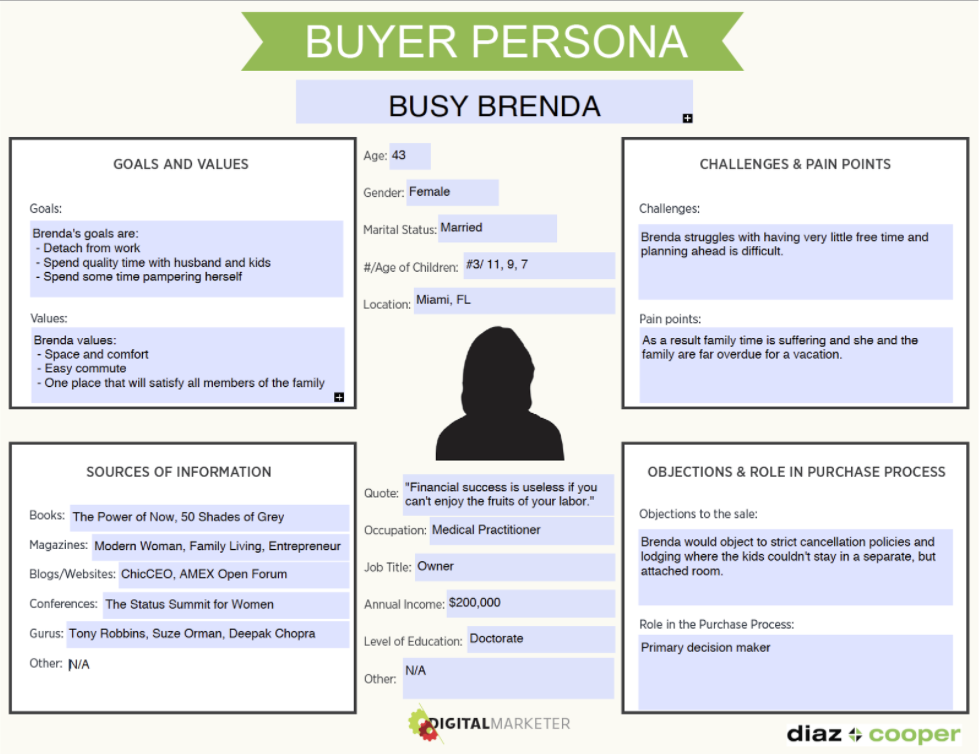
In this case Busy Brenda is a married mother of three. She and her husband are both working professionals, which has enabled them to create a pretty nice life for themselves and their children. Their combined incomes are well into the six figures. They own a nice home. Their kids are enrolled in private school. For all intents and purposes, life is good.
However, due to their busy work schedules, free time is in short supply and family time tends to suffer. Planning ahead is difficult. Still, they’re desperately overdue for a family vacation that will work for a pre-teen, a 9-year-old, a 7-year-old and two very weary parents.
Now that you’re laser focused on a segment of people who are most likely to buy from you, you’re ready to craft the right messaging.
The 8-Question “Before/After” Grid
When someone decides to purchase from you, they aren’t actually buying your product or service… they’re buying the transformation your product or service makes possible: From an undesirable “BEFORE” state (like bored or stressed out) to a desirable “AFTER" state (like exhilarated or relaxed).
In order to get more people to buy, you need to transition from generic, "one-size fits all" messages to articulating the move from the “before” state to the desired “After” state in a way truly resonates with your ideal buyers.
Here are eight questions you need to ask yourself about how you transform your ideal buyer’s life with your product/service:
What does your prospect HAVE in the “Before” state?
What does your prospect HAVE in the “After” state?
How does your prospect FEEL in the “Before” state?
How does your prospect FEEL in the “After” state?
What is an AVERAGE DAY like for your prospect in the “Before” state?
What is an AVERAGE DAY like for your prospect in the “After” state?
What is your prospect’s STATUS in the “Before” state?
What is your prospect’s STATUS in the “After” state?
Your marketing message needs to express your understanding of each of these phases as you take your buyer persona through a before and after journey.
Here’s an example of what a Before and After Grid for the resort guest "Busy Brenda" could look like:
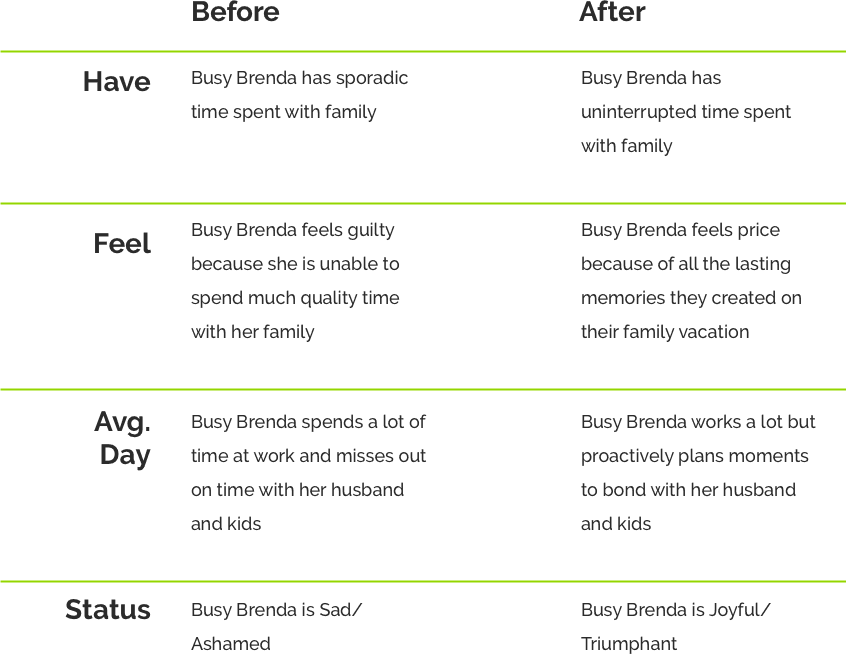
Step 2 – Choose your Traffic Source(s)
Congrats! You know how to define your buyer persona and how to craft your marketing message. So, now it’s time to figure out where you will go to find your buyer persona and compel them to visit your website so they can enter your conversion funnel.
Before we go any further, however, let’s make something crystal clear: This is the easiest part!
Not only are platforms like Google, Facebook, LinkedIn, Twitter, Instagram and Pinterest lining up to deliver all the traffic to your website that you can imagine, but there are tons of other channels (some you may already use) you can use to drive visitors to your website.
In the book Traction, by Gabriel Weinberg and Justin Mares, the authors outlined no less than 19 traffic sources from which you can choose. These sources include:
- Targeted blogs
- Publicity, such as online releases
- Unconventional PR
- Search Engine Marketing (Google, Bing, etc.)
- Social Media Ads (Facebook/Twitter/YouTube ads, etc.)
- Offline ads
- Organic Search Results (Search Engine Optimization)
- Content marketing
- Email marketing
- Programmatic Display Ads
- Video marketing
- Business development (inside sales)
- Direct sales
- Affiliate programs
- Existing/owned platforms
- Trade shows
- Offline events
- Speaking engagements
- Community building
That’s a lot of traffic sources!
The thing is, where you get your visitors from doesn’t matter too much.
You simply need to understand:
- How to measure what a visit to your website is worth
- How to extract the maximum immediate value from those visitors
You can try to drive traffic through tactics like blogging, Facebook Ads, or email marketing, but first you need to understand the system.
The goal, no matter which traffic source you choose, is to drive prospects into the CVJ Sales Funnel so that traffic can convert. Traffic that does not convert to a lead or sale is a waste of time and money.
Become the master of a single, steady traffic source.
We recommend starting with one traffic source – focus on it, work it, master it, and then add additional sources to introduce more prospects into your conversion funnel. We call this the “land and expand” approach and it works.
Your traffic strategy for acquiring new leads and customers begins and ends with driving visitors into the CVJ funnel.
This leads us right to the Lead Magnet…
Step 3 – Offer a Lead Magnet
The Lead Magnet is an irresistible offer that gives specific value to a prospect in exchange for their contact information.
Make no mistake, although no money changes hands, this is a transaction – and, it is often the first transaction you will have with a website visitor.
The Lead Magnet exists to increase contacts/subscribers (in other words, leads!) in your database because most visitors to your website aren’t yet ready to purchase on their first visit to your website. In fact, statistics show that the majority of visitors aren’t ready to buy on the first visit.
96% of visitors aren’t ready to purchase or request information on their first visit to your website.
Because the Lead Magnet is the very top of the CVJ Funnel, increasing opt-ins here will pay dividends throughout the rest of the system.
But all Lead Magnets are not created equal: You will need to provide tremendous value with the Lead Magnet.
That said, the common practice of asking for email with a “Subscribe to Our Newsletter” call-to-action is NOT a Lead Magnet! What incentive do they have to give you their precious email – what immediate value will they receive? None. That's why most forms convert less than 2% traffic on average.
On the other hand, the best Lead Magnets will convert north of 50% of visitors into leads. The highest performing Lead Magnets all have one thing in common…
Specificity!!!
This is the key to getting more leads.
You DO NOT need to create something lengthy or complex. However, the more laser-focused your Lead Magnet is — the better it will convert.
So, for example, this is NOT a good Lead Magnet… can you see why?
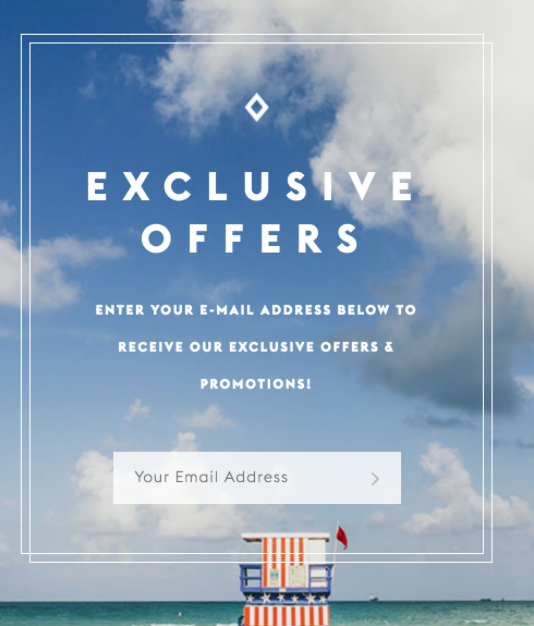
Sure, it's pretty. There is an offer but it isn’t specific enough…
Your prospect might enjoy exclusive offers, but, even more importantly they want to solve a problem. They want an outcome. This is too vague.
Contrast the prior example with the specific problem that is addressed in this Lead Magnet from BOOM! By Cindy Joseph cosmetic line.
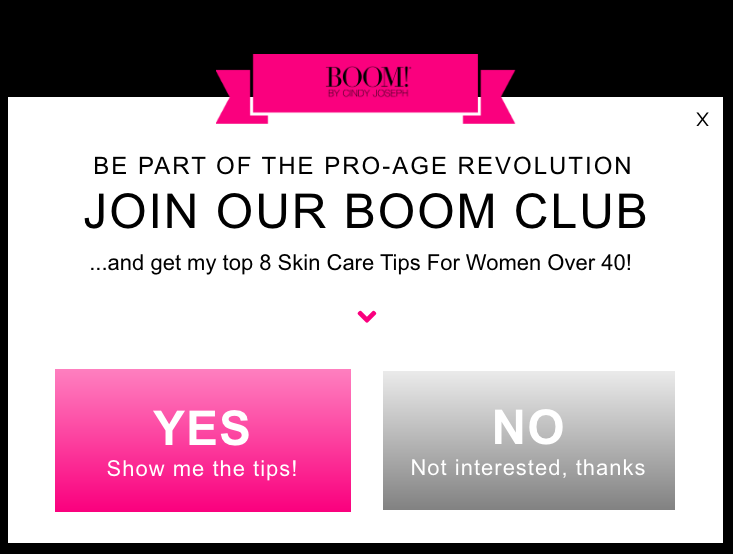
This Lead Magnet speaks directly to the company's Buyer Persona (women in their 40's) and provides a specific solution to help them look and feel beautiful at any age.
A Lead Magnet that solves a specific problem for a specific segment of the market will generate more leads. This will be a lot easier after you’ve created your Buyer Persona and completed the Before and After Grid, because you’ll have a clear idea of the problems they face and the solutions that can get them closer to their desired outcome.
What irresistible "bribe" could you offer in exchange for a prospect’s contact information?
How do you promote your Lead Magnet?
The Lead Magnet is usually offered on a web page called a landing page that is optimized to convert even cold traffic into leads; but it can also be delivered through lead flows, chatbots, embedded lead forms, and other conversion rate optimization tactics.
Regardless of the vehicle you use to promote your lead magnet, the presentation doesn’t need to be fancy.
Here’s a high-performing landing page from Snack Nation
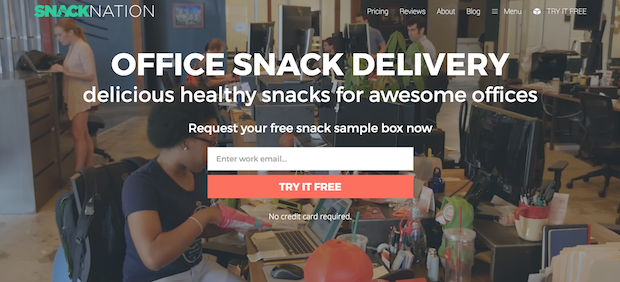
Using a targeted Landing Page results in a more informational lead, rather than a new random email from a person you know nothing about. When you use your Lead Magnet to entice a website visitor to give you their contact info, you see what the lead is interested in and you get a potential customer who is already predisposed to buy from you.
Now, you may be thinking this is the time to hit them over the head with your offer to buy your top-selling products or services.
And you wouldn’t be wrong... at least not completely.
If you want to maximize the rate of leads you convert into customers, before you go into selling your primary product, you want to offer a Tripwire.
Let’s take a closer look at this next step of the CVJ Model...
Step 4: Offer a Tripwire
At this point, we’ve acquired qualified leads with your Lead Magnet – woo hoo!
But, they are not new guests/customers yet – boo!
Even though your new lead has expressed their interest in your solutions through your Lead Magnet, a large percentage of them are likely still not ready to purchase your flagship product, high-end experience, or premium service... at least not yet.
If you understand and execute on this step, you will surely convert more visitors into customers than most of your competitors.
What exactly is a “Tripwire”?
The Tripwire is an entry-point offer designed to convert your new qualified leads into paying customers. It turns window shoppers into customers.
The most common way to make the Tripwire irresistible is by selling it at cost and, in some cases, at a loss to you – but, this isn’t the old auto dealership “bait and switch” loss leader concept.
The Tripwire is a REAL offer, it’s just that you aren’t trying to make a living from selling Tripwires. You are selling Tripwires with the sole purpose of acquiring buyers because there is nothing more valuable than a list of buyers.
There is nothing more valuable to your business than a list of people
who have bought from you already.
This step is not designed to maximize profits. Heck, it’s not even supposed to cover your bills. You’re probably thinking about skipping this step after that statement (C’mon you know I’m right!)
Don’t skip it!
When you understand the rest of the Customer Value Journey optimization process, you will understand how the Tripwire Offer is the single most powerful addition you can make to your conversion funnel — even though you may not make any direct profit from it.
The Tripwire is not a new idea.
The Tripwire is essentially a loss leader. Retail businesses have been using this pricing strategy for years to get people to make the first purchase and stimulate sales of more profitable goods or services. Think Black Friday doorbusters.
Let’s take a walk down memory lane for a dated but incredibly powerful example of a good Tripwire. If you’re old enough to remember it, you may have even signed up for it.
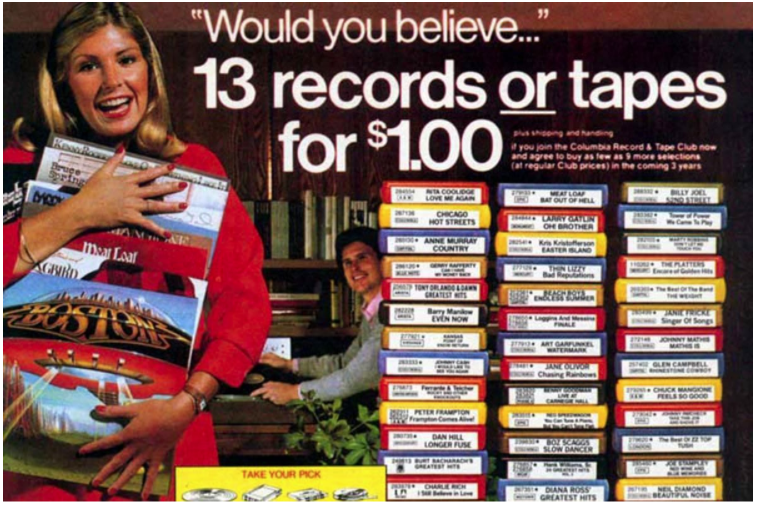
This offer from Columbia House is one of the best-known and most effective Tripwires ever created. Simply put, buyers paid a super small fee to get their first taste of a worthwhile product and then became long-term customers as they rolled into the monthly subscription service.
- Low-dollar amount — check!
- Valuable product — check!
Today, you can use this same approach to fuel the conversion funnel for your products and services, allowing you to convert more sales at a higher-margin.
Still feeling a bit skeptical?
Let’s take a look at a more relevant example.
Timeshare companies have been effectively using Tripwire offers for years...
In order to entice prospective buyers to visit their timeshares, they’ve offered discounted or free stays to hotspot destinations, as well as tickets to nearby attractions. Typical Tripwire offers might include:
- Three nights in an Orlando hotel and two tickets to Disney theme parks for $99
- A stay in a Las Vegas hotel and free gambling credit for $44 per night
- Three days and two nights in a luxury resort, plus two theme park tickets for $169
For eCommerce, a Tripwire is usually a deeply discounted item in your store. Some other relevant Tripwire ideas include:
- Selling kitchen design at a steep discount to encourage the purchase of the kitchen cabinets
- Selling a tour at a discount to incentivize the purchase of higher-margin add-ons such as meals, souvenirs, drinks, or photos.
- Offering a free consultation, demo or analysis for a B2B service or software
- A mini online course (yes, this can be used for a Tripwire idea too)
Why is offering a Tripwire worth my effort?
Remember the stats we shared earlier? Here's another sobering one...
Only 17% of consumers browse a website with an intent to purchase on their first visit, according to the 2018 Reimagining Commerce study by Episerver.
In fact, only half (50%) of shoppers immediately head for the product they want to purchase. You have to woo them, motivate them and hook them.
The strategy behind the Tripwire is simple: Convert the maximum number of Lead Magnet leads into paying customers, even at the expense of your profit margin, with the understanding that acquiring a paying customer will deliver profit through the next three steps:
Step 5 – Offer Your Core Product
Step 6 – Offer A Profit Maximizer
Step 7 – Establish A Return Path
When you offer a Tripwire your goal is to also achieve the following:
- Increasing rapport and trust with your Buyer Persona
- Getting a “micro-commitment,” which makes it easier to make a bigger purchase later (Note this can be a money or time commitment)
- Break even on your cost of customer acquisition
Before we leave this step, let’s take a closer look at customer acquisition costs…
How can I figure out my customer acquisition cost (CAC)?
It really is a simple equation:
- Calculate the total amount spent on acquiring more customers (marketing and sales expenses)
- Calculate the total number of new customers acquired in the period the money was spent.
- Divide total expenses by the number of new customers.
For example, if a company spent $2,000 on marketing in a year and acquired 100 customers in the same year, their CAC is $20.00.
With a well-executed conversion funnel, you can cover these costs with your Tripwire, so every purchase or upsell that comes afterwards becomes pure profit. Once you calculate your customer acquisition costs, you can build a Tripwire packed with enough value that you can sell it at a price high enough to cover your CAC.
Once you’ve turned your lead into a customer with a Tripwire, it’s time for the next step…
Step 5: Offer your Core Product
You’ve done the hard work of attracting prospects into your conversion funnel with your Lead Magnet and turned them into paying customers with your Tripwire, now it’s time to get some real sales revenue into your business by offering your core product!
Good news – you already have your Core Offer ready to go!
Your Core Offer is your flagship product or service (the one most of your customers buy that also gives you great margins).
There’s no need to create anything new.
Most companies stake their entire livelihoods on making cold offers of their core products to cold prospects with minimal results. We encourage you to reject that approach.
With the addition of the Lead Magnet and Tripwire Offer, you should see your Core Offer sales grow exponentially!
After all, you’ve already had two successful transactions with this buyer.
Entrepreneur and marketing expert Marcus Sheridan points out that “a successful marketing funnel depends on how well you establish and nurture relationships with your market.” Depending on the price point of your product/service, your customers may need more or less communication.
This is why it’s critical to over-deliver value with the Lead Magnet and Tripwire.
If you build out your conversion funnel using the Customer Value Journey optimization model, you’ll have a pipeline of qualified leads and Tripwire buyers (customers) – when done right, this will have shown the value of your offering, giving you the opportunity to charge a premium and making sales of your Core Offer profitable – even in a price competitive environment.
But, your Core Offer doesn’t have to be the only way to gain profit. If you follow through on the CVJ process, you could take some of what you make from the Core Offer and reinvest it to acquire more customers. Then use the next steps to truly create profit.
This is how your business becomes unstoppable.
The CVJ model empowers you to spend more than your competitors to acquire a customer.
It may sound crazy, but you actually stand to generate the most profit for your business in the next two steps: Step 6 – Offer A Profit Maximizer and Step 7 – Establish A Return Path.
Let’s take a look at how those work...
Step 6: Offer a Profit Maximizer
Would you like fries with that? Warranties, maintenance plans, add-ons, cross-sells and upsells, you name it – any offer made after the core product is a Profit Maximizer, and this is where smart companies can maximize their cash flow.
The world’s most successful brands generate the bulk of their margins from Profit Maximizers.
Check out these examples:

- Express oil change companies like Jiffy Lube don’t see much net revenue from their core offer of oil changes. After the cost of supplies and employees, there isn’t a lot left over. The real money comes in with added services like tire rotations, air filter changes, and changing belts.
- McDonald's spends a fortune on advertising and burger sales probably cover the cost of customer acquisition, but not much else. It’s when customers buy fries and a soda that the franchise owner generates the real money.
- Best Buy makes little profit on high-cost items like TVs and computers which are expensive wholesale. But, the company maximizes profits through sales of accessories, warranties and technical support.
What could you be offering as an upsell or cross-sell? What could you bundle with your Core Offer? How can you incorporate a subscription or membership into your business model?
Amazon does a great job of this with "recommended for you" and "people also viewed" recommendations during checkout - this is fairly easy to mimic on an eCommerce site.
Remember to shape your Profit Maximizers to ensure that these upsell and cross-sell efforts are in tune with your core product, your brand and values. Doing this helps to ensure that customers keep coming back.
And that means more profit generated by your business.
Once you've created your Profit Maximizers, it's time for the final step...
Step 7: Establish a Return Path
Tripwire and Core Offer purchases are not enough — not if you’re looking to maximize profits for your business. Establishing a Return Path is the step that turns an isolated transaction into multiple future transactions.
Anything that brings the customer, visitor, or lead back to engage with you more frequently is a return path, including…
- Exit offers and down sells
- Organic social media that sparks a conversation
- Loyalty programs
- Special offers and coupons (be careful not to devalue your brand!)
- Content marketing – guides, checklists, and white papers
- Outbound sales calling
- Ad retargeting efforts
The objective of the Return Path is frequent, strategic communication with your buyers and leads in an effort to get them to buy from you again and again.
Develop a process, ideally automated, for sending out new content, new offers and informational updates about your company and your offerings products via email, phone, or mail.
Our preferred Return Path is email marketing automation. Because you have received website visitors’ contact information through the Lead Magnet, you have permission to email your leads in order to bring them back to the Tripwire, Core Offer or Profit Maximizer that they didn’t buy the first time around. (Yes, this means ideally you have multiple offers!)
Likewise, you have permission to email your customers (past customers and Tripwire purchasers) to offer them new Lead Magnets, that lead to new Tripwires, Core Offers, and Profit Maximizers increasing their frequency of purchases and, ultimately, maximizing the average Customer Lifetime Value for your business.
At a minimum, you should build an autoresponder email series to cover every step in your funnel where a prospect could exit without taking the next offer.
This “Email Follow-up Machine” will provide you with exciting new opportunities to extend value, drive additional sales and upsell revenue-rich add-ons and upsells, producing compounding results that you will see in your bottom line.
Conclusion
And there you have it, the 3 ways to grow your business and the 7 steps to build an effective digital marketing funnel. Here's a quick summary of what we covered:
Get More Leads/Customers
Step 1. Determine Your Product/Market Fit
Define your ideal customer by creating a Buyer Persona. This helps you to craft message, offers, and content uniquely designed to create value on your customers’ terms.
Step 2. Choose Your Traffic Source(s)
This is where you go to find and invite your Buyer Persona to come visit your website. Viable traffic sources include, but are not limited to: Facebook Ads, Google Ad, Blogs, SEO (Organic Search), etc.
Step 3. Offer A Lead Magnet
This is a free and valuable offer that your audience can get in exchange for giving you their contact information. It establishes trust with potential customers, gives them something of value before they buy, and gives you permission to follow-up with them they don’t buy on the first visit to your website. PRO TIP: To maximize effectiveness, include helpful resources that go beyond your product or service.
Step 4. Offer a Tripwire
Creating a low-cost “entry-point offer” transforms a lead into a customer, warms them up to purchase your core offer and allows you to recoup some of the money you spent on promotions to get them there in the first place.
Step 5. Offer Your Core Product
This is a standardized offering that represents both what people buy from you most and creates profit for your company. You might want to read that again: We’ve seen many clients who discovered that their core product was something other than what first came to mind after re-reading that last line. :-)
Get Them To Spend More
Step 6. Offer A Profit Maximizer
This is an upsell that adds value to your Core Offer for your customer, as well as margin to the sale for you. There several different types of profit maximizers you can deploy – I’ll share more on that later in this article.
Increase Buying Frequency (Loyalty)
Step 7. Create A Return Path
Establish ongoing customer conversations and offers to bring your guests/customers back for more. Repeat buyers are not only more profitable than new buyers, but also these brand loyalists help you lower your cost of acquiring new customers by promoting your brand to others.
By utilizing the Customer Value Journey optimization model as your guide, you are on your way to building what Ryan Deiss calls “An Unstoppable Business.”
Next Steps...
Are you ready to see how you can make Customer Value Journey optimization work in your business?
Let’s take the next step together.
We worked with some folks to put together a comprehensive list of all the different tactics you can use to grow your business – Remember Attract More Customers, Increase Transaction Value, and Increase The Number Of Transactions?
We'd like to go over this list with you and figure out the ONE BIG THING you should be focusing on so you can get a fast start to putting the CVJ model to work.
If you'd like to explore how this proven digital marketing system can work for your business...